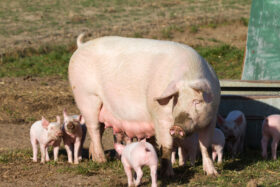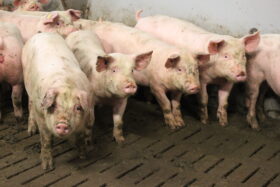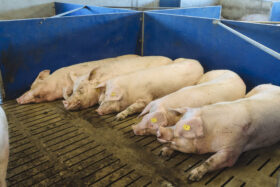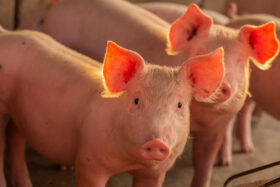Conference Report
Essential oils, secondary plant compounds, phytogenics – all these expressions can be found in the context of animal feed. In the following, Dr. Sabiha Kadari, Regional Technical Director Southeast Asia/Pacific at EW Nutrition, will show the difference between essential oils and phytomolecules and the science behind phytogenics.
Essential oils and phytomolecules– not the same
Let us first show what are essential oils using the example of oregano oil. Essential oils are extracted from plants and unpurified mixes of different phytomolecules. The raw oregano oil extract contains carvacrol, thymol, P-cymene, and several other phytomolecules. The concentration and composition of these phytomolecules can vary significantly, depending on factors such as geographical origin, seasonal variations, plant part, plant growth stage and harvest time, extraction methods, and post-harvest processing. As a result, there can be significant batch-to-batch variations, resulting in differences in animal performance. Furthermore, there is the potential for the presence of undesirable contaminants.
In contrast, phytomolecules are the active ingredients in essential oils or other plant materials. They are clearly defined as one active compound (IUPAC name/CAS number) by their unique chemical structures, such as carvacrol. By focusing on specific active compounds, standardized products don’t have batch-to-batch variation, enhancing consistent animal performance.
Stringent screening processes
To yield the best phytogenic formulations for animal production, a rigorous screening process is required:
The initial screening process consists of ensuring the bioactives are generally recognized as safe (GRAS) by the US Department of Agriculture and approved by the European Food Safety Authority (EFSA). This step is crucial to ensure that any compounds used in formulations do not pose health risks to animals or humans.
In addition to being selected for their chemical-physical properties, which play a significant role in determining how well the phytogenics will perform in various applications, and a thorough cost-benefit analysis, the phytogenics are mapped for their following biological activities.
Antioxidant
Phytomolecules exert their antioxidant effects through various mechanisms, including scavenging free radicals. The ORAC (Oxygen Radical Absorbance Capacity) test is widely regarded as a gold standard for measuring the antioxidant potential of phytomolecules. It quantitatively assesses the ability of compounds to scavenge free radicals, providing a reliable comparison against a known standard, specifically Trolox, a vitamin E analog. Trolox has well-documented antioxidant properties, making it a reliable benchmark for evaluating the effectiveness of other antioxidants.
Antimicrobial
Incorporating a comprehensive approach to testing the antibacterial properties of phytogenics is essential for developing effective feed additives. The antibacterial properties should not only be tested against harmful enteropathogenic bacteria, such as Clostridium perfringens, E. coli, and Salmonella. It should also be evaluated if beneficial species such as Lactobacilli, the proliferation of which is wanted, are preserved.
By evaluating both pathogenic and beneficial bacteria, researchers can ensure that phytogenic formulations support optimal gut health and reduce the reliance on antibiotics.
Anti-inflammatory
Anti-inflammatory properties also help to modulate the gut-associated immune system and mitigate excessive immune response so that animals can allocate more energy towards growth and production. This shift is vital for optimizing feed conversion ratios and overall performance.
Dr. Kadari noted that “EW Nutrition uses nuclear factor kappa beta (NFkß), which regulates the expression of various pro-inflammatory cytokines, and interleukin 6 (pro-inflammatory) and 10 (anti-inflammatory) cytokines as biomarkers, for measuring anti-inflammatory activity. A reduction in NFkß and the ratio of IL-6/ IL-10 indicates a decrease in inflammatory response.”
Anti-conjugation
Conjugation is a common mechanism of horizontal gene transfer that is instrumental in spreading antibiotic resistance between bacteria. “Most resistance genes are found on mobile genetic elements named plasmids and primarily spread by conjugation,” explained Dr. Kadari.
Cell stress of bacteria modulates the conjugation frequency. Among these stressors are antimicrobial phytogenics. The goal is to keep the conjugation frequency below the one that could occur under unchallenged conditions.
Figure 1: High throughput screening allows EW Nutrition researchers to quickly conduct millions of chemical, genetic, or pharmacological tests

Delivery mechanism
Lastly, to optimize the benefit of the selected phytogenics and deliver consistent results, the substances must be protected by, e.g., encapsulation to ensure homogenous distribution in feed and thermostability in pelleted feed. A special delivery system provides for the targeted release of the active ingredients within the organism, specifically ensuring that these compounds are effectively utilized within the body rather than eliminated through the feces. This is crucial for optimizing their benefits in animal production.
Phytomolecules are an essential support in antibiotic reduction
“Phytogenics are increasingly recognized as effective alternatives in antimicrobial reduction programs. The combination of stringent screening processes alongside rigorous in vitro and in vivo testing is essential for ensuring that phytogenics deliver optimal and consistent performance in animal production,” noted Dr. Kadari.
EW Nutrition’s Swine Academies took place in Ho Chi Minh City and Bangkok in October 2024. Dr. Sabiha Kadari, Regional Technical Director at EW Nutrition SEAP, was one of the highly experienced speakers of EW Nutrition. With expertise in feed cost optimization, feed additive management, audits, and lab support, she provides customized technical solutions and troubleshooting challenges for customers.













